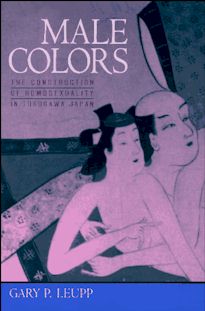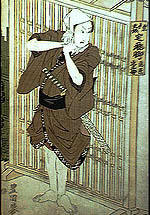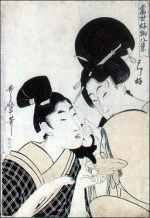 |

 |
|
By Gary P. Leupp Book Review by Joseph R. Hawkins Male Colors: The Construction of Homosexuality in Tokugawa Japan by Gary P. Leupp University of California Press, 1995, bibliography, illustrations, index, $45  Tokugawa Japan ranks with ancient Athens as a society that not only tolerated but positively celebrated male-male sexuality. Few scholars, however, have seriously studied the early modern Japanese homosexual tradition, sought to explain its origins, or explored how its particular conventions reflected class structure and gender roles in an especially dynamic preindustrial society.
Tokugawa Japan ranks with ancient Athens as a society that not only tolerated but positively celebrated male-male sexuality. Few scholars, however, have seriously studied the early modern Japanese homosexual tradition, sought to explain its origins, or explored how its particular conventions reflected class structure and gender roles in an especially dynamic preindustrial society.
Male homosexual behavior in Tokugawa Japan rarely constituted an exclusive lifestyle; bisexual behavior was the norm. Leupp argues that although some men were exclusively homosexual, "nurture" (rather than "nature") factors contributed to the male-male sexual behavior that was so conspicuous in this society. These factors included the absence of women form monastic society and their scarcity in samurai society, skewed sex ratios in Tokugawa cities, and the culture surrounding kabuki theater and the associated world of male prostitution.
Leupp follows nanshoku , a word which literally means male colors but refers to male same-sexual practices, throughout the Tokugawa period in this largely archival work. Though all of the information that Leupp provides is not news to those interested in the history of homophile studies in Asia, his presentation is thorough and well organized and much of it is revealed for the first time to scholars in the West. The first chapter deals with the pre-Tokugawa history of same sexuality in Japan, China, Korea and India, and the influences these and other areas had on Japan's construction of a sexually variant imaginary. Leupp like a miner in the excavation of history shines his light onto various aspects of life, sex, gender and religion. Chapter two of the book deals with the "commercialization" of nanshoku. Leupp says, "male-male sex became largely a commercial transaction devoid of the commitments required by earlier traditions of male homosexuality." Though it is perhaps true that prostitution was widespread, it does not follow as Leupp suggests that these commercial exchanges were so prevalent that they eclipsed non-commercial exchanges of love and affection. Non-commercial exchanges may have been just as popular but less recorded. The traditions of commitment that Leupp speaks of in the quote above: pacts of fealty, samurai bonds and the like, have long been a part of Japanese history and though they may have weakened during the Tokugawa period it seems unlikely that they were simply non-existent in that era. This is a most difficult problem for those of us excavating this "archaeology of knowledge" regarding sexual variance. In our zeal to find the homopositive past we hope and believe that the information that we find is a representative sample. This is a dangerous assumption. It is an assumption that leads Leupp to make conclusions regarding the same-sexual practices of the Tokugawa that are often speculative at best. I do not argue with Leupp's excavations but I dared to hope for more digging. Leupp's excavation of the commercial in the Tokugawa period is interesting and extensive. He follows the formulation of the Tokugawa Pax and the attendant economic changes that left most samurai idle and created rifts within the class hierarchies of Japanese society. This left a space for the emergence of the floating world of pleasure. Thus, young boys, girls and women were commodified as purchasable goods. This created a new thriving market for prostitution.
 Chapter three, "Tokugawa Homosexual Culture," is replete with illustrations and information. Leupp's tour of the period illuminates the kabuki theater where pleasure and hedonistic completion were the goals. Whether this was found in the drama itself, backstage in the brothels or in peripheral worlds which sometimes were actually the main attraction, Leupp has been careful to follow various trends in the developments of the sexuality of the period. The kagemajaya, or teahouses, theaters and all the locations of the demi-monde are probed.
Chapter three, "Tokugawa Homosexual Culture," is replete with illustrations and information. Leupp's tour of the period illuminates the kabuki theater where pleasure and hedonistic completion were the goals. Whether this was found in the drama itself, backstage in the brothels or in peripheral worlds which sometimes were actually the main attraction, Leupp has been careful to follow various trends in the developments of the sexuality of the period. The kagemajaya, or teahouses, theaters and all the locations of the demi-monde are probed.
The hatred of women by some males reaches almost cult status in the Tokugawa period. The onnagirai or women haters are one part of the development of a homosexual culture in Tokugawa Japan. Leupp neatly divides homosexuals into two groups: those who hate women and those who do not. Somehow this oversimplification detracts from the possible psychological analysis of the complexity of the period. Leupp also fails to problematize sufficiently the limitations provided by the materials he digs out. Though it is true that much of what is offered up illuminates a good portion of the culture of the time and from this extrapolations may be made regarding other possibilities, if there is a failure in Leupp's work it is the failure to effectively place his excavations within the non-written historical context of the times. Widespread literacy did not flourish in Japan until later and thus there are people without voices in the works that Leupp has brought up for us. Sexually explicit texts are sifted for the exegesis they provide regarding methodologies and an aesthetics of sexual praxis. Again, the information provided is excellent but the voices of the unheard are deafening. As with many studies of Japan this book concentrates on Edo (Tokyo) and provides little, by comparison, in terms of a view into the surrounding trade centers, daimyos and other major cities. It is good deal like writing a book about America in which one studies only New York. Perhaps the problematizing of this as an issue for further study would have been enough. Chapter three's title "Social Tolerance" is perhaps the book's most questionable point as the word tolerance implies that the Japanese of the Tokugawa period "put up" with sexual variance. Leupp's case regarding sexual practices of the period would seem to negate this kind of presumption. For example, Leupp refers to the widespread evidence for the prevalence of bisexuality among Tokugawa men, and yet, if this is true what does it say for the "construction" of gender in that time and place? How was bisexuality constructed? If people were bisexual does it follow that they "tolerated" same sexual behavior? Leupp's book offers factual information here but presents little in the way of a sound theoretical interpretation of the placement of the behaviors he illuminates. Likewise, in his examination of the Buddhist monasteries, where same-sexualities, as in most homosocial societies may have been more prevalent, the role of such institution is again not problematized sufficiently. Recent work suggests that Buddhist monasteries may have been a place where the exclusion of homosexuals from a wider social context might have been accomplished. Families not desirous of raising feminine sons may have shipped them off to the monasteries. Nunneries may have provided an equivalent space for females. What were the attitudes of the people or the society of the times? This is a question that Leupp courts with his illumination, flashing his light across hidden historical enclaves, but in the end mysteries remain in the shadows. Part of this is not Leupp's own lack of attention but the shear absence of good data available to examine. That having been said, a little more mention to these omissions could have challenged the reader to look beyond the facts presented. The next chapter "Nanshoku and the Construction of Gender" offers many interesting ideas on the "construction" of homosexuality. Discussions of homosexuality need not always frame themselves in the camp of the social constructionists or the camp of the biological determinists. Many of us are willing to admit at least the possibility of the influence of both and get on with the business at hand. This business at least in part is the revision of history to include sexually variant peoples and to provide advocacy for those who feel the ire of discrimination. Leupp seems blessedly less interested in making a case for social constructions of homosexuality than with presenting archival data and historical views on the subject. He works diligently to avoid ethnocentricities here and comes a long way toward providing an emic perspective. Leupp's "Conclusions and Speculations" is short and deals only briefly with any analysis of the materials mentioned. The strength of this book is not in conclusions and in analyses but in its cohesive presentation of a difficult body of archival material. Leupp is to be admired for his perseverance and dedication. This work was not easily achieved and must not have come without a cost to its writer. For anyone interested in cross-cultural comparisons of homosexuality, and in the history of sexuality in Japan more specifically, this book will prove a rich source work. It also points to a problem that has emerged regarding scholarship in cross-cultural analyses of gender. Many who have spent the necessary time obtaining language proficiency in Japanese are less adept at navigating the dangerous waters of gender politics and theorizing in the west. Yet without a firm grip on current theoretical constructs many works fail to problematize concepts of borrowed terminologies and to perceive the role of economy, mythology, psychology or politics in the production of work on gender. Leupp has clearly worked hard to produce a volume that addresses a good deal of this or, at the very least, to avoid trite or hegemonic eurocentric perceptions of Japanese sexuality in the Tokugawa period. For the most part he succeeds. In fact, this book does a really good job of excavating the layers of sediment that compose a history of gender in Japan. What Leupp has provided is most importantly an invaluable resource work that offers gender researchers a place to start in their further excavation and revision of the global history of sexuality and love. There are aspects of Male Colors that I feel should have been problematized to a greater extent. The use of western terminology in reference to indigenous Japanese practices is dealt with in a somewhat surreptitious manner. Though I sympathize with Leupp's dilemma as a writer. (The use of terms like same-sexuality and variance do become cumbersome in writing and require readers to become more active participants in reading.) I think language and indigenous presentation deserve more exploration. Leupp attempts to clarify his usage of various terms in his introduction, yet still the book fails to paint a sufficiently non-eurocentric version of historical events and this will have to happen if the field of sex and gender studies is to make progress in Japan or (O)ther places.
 Further, the use of some feminist theoretical works regarding the male gaze, poststructural and postmodernist psychological work might help in the deconstruction of these problems of excavating the past. Leupp does refer briefly to the problems of language in his chapter on homosexual culture yet the very use of the word homosexual to define a separate culture- when the argument has been made, and I believe rightly so, for a more bisexual or polymorphous ethos in Japan- contradicts the use of terms like this in reference to indigenous practices.
Further, the use of some feminist theoretical works regarding the male gaze, poststructural and postmodernist psychological work might help in the deconstruction of these problems of excavating the past. Leupp does refer briefly to the problems of language in his chapter on homosexual culture yet the very use of the word homosexual to define a separate culture- when the argument has been made, and I believe rightly so, for a more bisexual or polymorphous ethos in Japan- contradicts the use of terms like this in reference to indigenous practices.
The miners light that Leupp wields though it sometime glazes across beds of alternative possibilities certainly gives us the first glimpses, in the West, of a part of an archeology of a past. It is for the rest of us to keep on digging using Leupp's map in the form of Male Colors as our guide. Joseph R. Hawkins is a doctoral candidate at the University of Southern California in the department of anthropology. His dissertation will deal with homosexuality in modern Japan. Review from the International Gay & Lesbian Review, ONE Institute Press, Los Angeles, CA |
 © 1997-99 BEI
© 1997-99 BEI